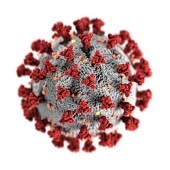 A study from Sweden published by The BMJ recently finds an increased risk of deep vein thrombosis (DVT) up to three months after COVID-19 infection, pulmonary embolism (PE) up to six months, and a bleeding event up to two months.
A study from Sweden published by The BMJ recently finds an increased risk of deep vein thrombosis (DVT) up to three months after COVID-19 infection, pulmonary embolism (PE) up to six months, and a bleeding event up to two months.
The findings also show a higher risk of events in patients with underlying conditions (comorbidities), patients with more severe COVID-19, and during the first pandemic wave compared with the second and third waves.
The researchers say these results support measures to prevent thrombotic events (thromboprophylaxis), especially for high-risk patients, and strengthen the importance of vaccination against COVID-19.
It is well known that COVID-19 increases the risk of venous thromboembolism (VTE), the authors write. However, they note that less evidence exists on the length of time this risk is increased, if risk changed during the pandemic waves, and whether COVID-19 also increases the risk of major bleeding.
To address these uncertainties, the researchers set out to measure the risk of DVT, PE, and bleeding after COVID-19.
Using national registries in Sweden, they identified more than one million people with confirmed SARSCoV-2 infection between 1 February 2020 and 25 May 2021, matched by age, sex, and county of residence to more than four million people who had not had a positive SARS-CoV-2 test result.
They then performed two analyses: in the first, they calculated the rates of DVT, PE, and bleeding in COVID-19 individuals during a control period (before and long after COVID-19 diagnosis) and compared it to the rates in different time intervals after COVID-19 diagnosis (days 1–7, 8–14, 15–30, 31–60, 61–90, and 91–180).
In the second analysis, they calculated the rates of DVT, PE, and bleeding during the period 1–30 days after COVID-19 diagnosis in the COVID-19 group and compared them to the corresponding rates in the control group.
The results show that compared with the control period, risks were significantly increased 90 days after COVID-19 for DVT, 180 days for PE, and 60 days for bleeding.
After taking account of a range of potentially influential factors, the researchers found a fivefold increase in risk of DVT, a 33-fold increase in risk of PE, and an almost twofold increase in risk of bleeding in the 30 days after infection.
In absolute terms, this means that a first DVT occurred in 401 patients with COVID-19 (absolute risk 0.04%) and 267 control patients (absolute risk 0.01%). A first PE event occurred in 1,761 patients with COVID-19 (absolute risk 0.17%) and 171 control patients (absolute risk 0.004%), and a first bleeding event occurred in 1,002 patients with COVID-19 (absolute risk 0.10%) and 1,292 control patients (absolute risk 0.04%).
Risks were highest in patients with more severe COVID-19 and during the first pandemic wave compared with the second and third waves, which the researchers say could be explained by improvements in treatment and vaccine coverage in older patients after the first wave.
Even among mild, non-hospitalised COVID-19 patients, the researchers found increased risks of DVT and PE. No increased risk of bleeding was found in mild cases, but a noticeable increase was observed in more severe cases.
This is an observational study, so the researchers cannot establish cause, and they acknowledge several limitations which might have affected their findings. For example, VTE may have been underdiagnosed in patients with COVID-19, testing for COVID-19 was limited, especially during the first pandemic wave, and information on vaccination was not available.
However, results were largely consistent after further analyses, and are in line with similar studies on the association between COVID-19 and thromboembolic events, suggesting that they withstand scrutiny.
As such, the researchers say their findings suggest that COVID-19 is an independent risk factor for DVT, PE, and bleeding, and that the risk of these outcomes is increased for three, six, and two months after COVID-19, respectively.
“Our findings arguably support thromboprophylaxis to avoid thrombotic events, especially for high-risk patients, and strengthen the importance of vaccination against COVID-19,” they conclude.
In a linked editorial, researchers at the University of Glasgow (Glasgow, UK) point out that despite the potential for new variants of concern, most governments are removing restrictions and shifting their focus to determining how best to “live with COVID-19.”
However, they say this study “reminds us of the need to remain vigilant to the complications associated with even mild SARS-CoV-2 infection, including thromboembolism.”









